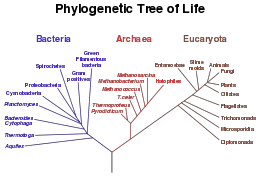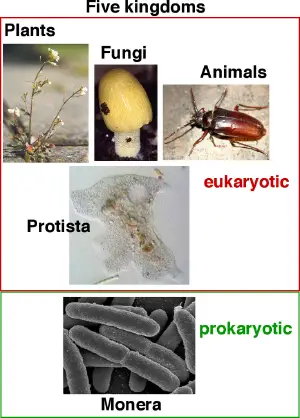Monera
Monera is an obsolete biological kingdom that comprised most living things with a prokaryotic cell organization (see Bacteria and Archaea). For this reason the kingdom was sometimes called Prokaryotae. Prior to its creation these were treated as two separate divisions of plants: the Schizomycetes or bacteria, considered fungi, and the Cyanophyta or blue-green algae. They later are now considered a group of bacteria, typically called the cyanobacteria, and are known not to be closely related to plants, fungi, or animals. Recent DNA and RNA sequence analyses has demonstrated that there are two major groups of prokaryotes, the Bacteria and Archaea, which do not appear to be closer in relationship to each other than they are to the Eukaryotes. All new schemes abandon the Monera and now treat the Bacteria, Archaea, and Eukarya as separate domains or kingdoms.
Traditionally objects were classified as animal, vegetable or mineral (see: Systema Naturae). After the discovery of microscopy, attempts were made to fit microscopic organisms into either the plant or animal kingdom. In 1866 Ernst Haeckel proposed a three kingdom system which added Protista as a new kingdom that contained most microscopic organisms[1]. Later, Haeckel proposed the fourth kingdom of which he called Monera. One of his eight major divisions of Protista was called Moneres. Haeckel's Moneres subcategory included known bacterial groups such as Vibrio. Haeckel's Protista kingdom also included eukaryotic organisms now classified as Protist. It was later decided that the Monera had proven to be too diverse to be seriously considered one single kingdom.
In 1969 Robert Whittaker published a proposed five kingdom system (Figure 1) for classification of living organisms[2]. Whittaker's system placed most single celled organisms into either the prokaryotic Monera or the eukaryotic Protista. The other three kingdoms in his system were the eukaryotic Fungi, Animals and Plants.

| Linnaeus 1735 2 kingdoms |
Haeckel 1866 3 kingdoms |
Chatton 1937 2 empires |
Copeland 1956 4 kingdoms |
Whittaker 1969 5 kingdoms |
Woese et al. 1977 6 kingdoms |
Woese et al. 1990 3 domains |
|---|---|---|---|---|---|---|
| (not treated) | Protista | Prokaryota | Monera | Monera | Eubacteria | Bacteria |
| Archaebacteria | Archaea | |||||
| Eukaryota | Protista | Protista | Protista | Eukarya | ||
| Vegetabilia | Plantae | Fungi | Fungi | |||
| Plantae | Plantae | Plantae | ||||
| Animalia | Animalia | Animalia | Animalia | Animalia |
Based on molecular phylogeny studies, Carl Woese proposed that the prokaryotes (monerans) be divided into two separate groups: Bacteria and Archaea. In Carl Woese's 1990 proposed phylogeny[3], these three kingdoms are all rooted in a universal common ancestor and this is the most widely accepted categorical phylogeny accepted today (see diagram to the right). However, the most modern interpretation for these three kingdoms is the "Universal and Eukaryote Phylogenetic Tree" based on 16s rDNA as presented on the Tree of Life website[4].
ReferencesISBN links support NWE through referral fees
- ↑ E. Haeckel (1866). Generelle Morphologie der Organismen. Reimer, Berlin.
- ↑ Robert Whittaker (1969) "New concepts of kingdoms or organisms. Evolutionary relations are better represented by new classifications than by the traditional two kingdoms" in Science Volume 163, pages 150-160. Entrez PubMed 5762760
- ↑ "Towards a natural system of organisms: proposal for the domains Archaea, Bacteria, and Eucarya" by C. R. Woese, O. Kandler, and M. L. Wheelis in Proceedings of the National Academy of Sciences U.S.A. (1990) Volume 87, pages 4576-4579. Full text online.
- ↑ "Universal and Eukaryote trees Based on 16s rDNA." by Mitchell L. Sogin (2006) Tree of Life website.
See also
- Bacterial cell structure
- Kingdom (biology)
Monera also called Prokayotae it is the kingdom of prokaryotic organisms that are unicellular that is a single-celled: consisting of a single cell & lack a true cell nucleus.
External links
- Bacterial evolution by Carl Woese (1987). Woese reviewed the historical steps leading to the use of the term "Monera" and its later abandonment (full text online). Entrez PubMed 2439888
Credits
New World Encyclopedia writers and editors rewrote and completed the Wikipedia article in accordance with New World Encyclopedia standards. This article abides by terms of the Creative Commons CC-by-sa 3.0 License (CC-by-sa), which may be used and disseminated with proper attribution. Credit is due under the terms of this license that can reference both the New World Encyclopedia contributors and the selfless volunteer contributors of the Wikimedia Foundation. To cite this article click here for a list of acceptable citing formats.The history of earlier contributions by wikipedians is accessible to researchers here:
The history of this article since it was imported to New World Encyclopedia:
Note: Some restrictions may apply to use of individual images which are separately licensed.
